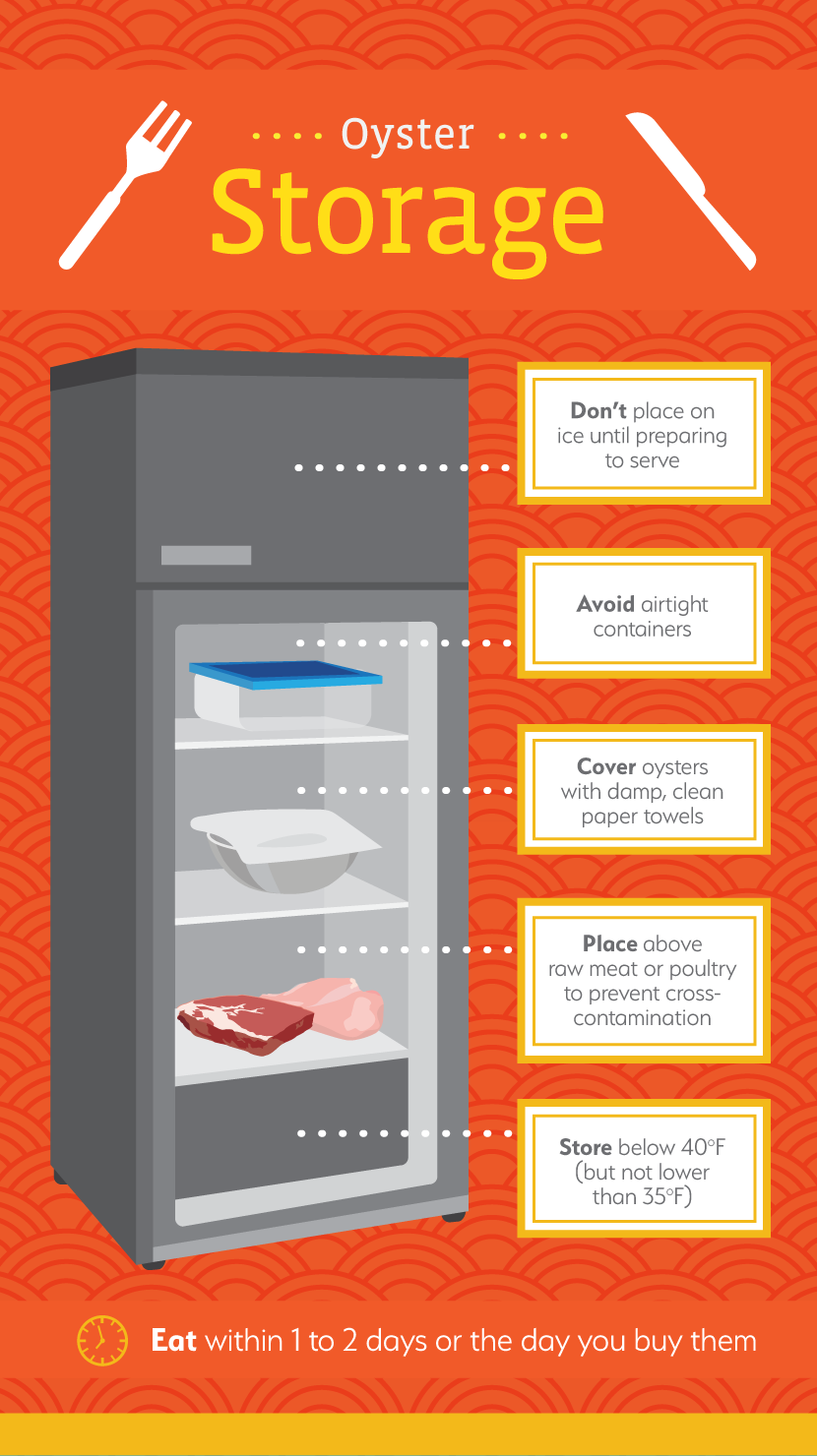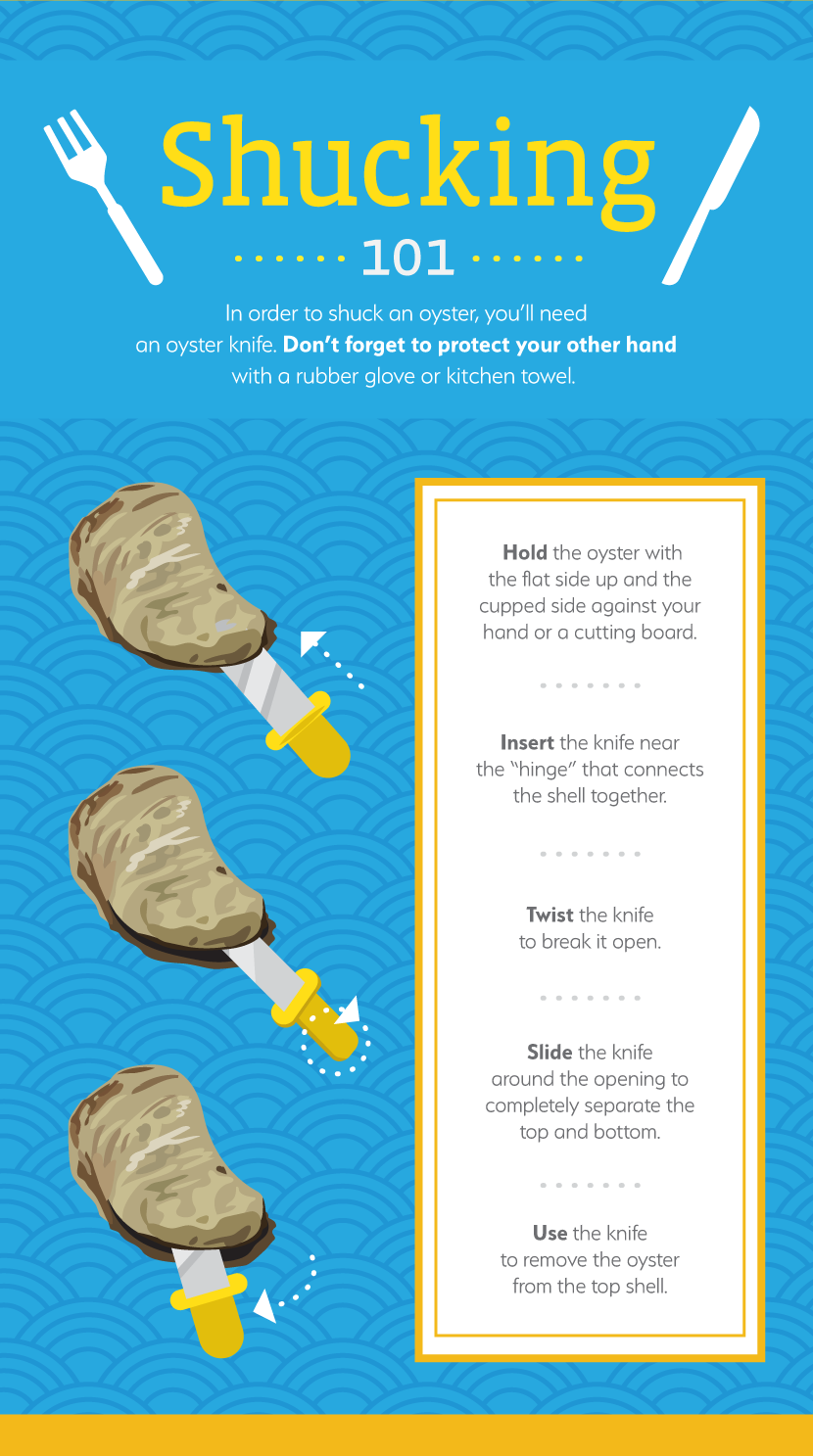Shuckin’ and Jivin’:
An Oyster Guide
If you’re a die-hard seafood fan, you probably know all about the tasty world of oysters.
These luscious shellfish boast a distinctive flavor reminiscent of the sea. You either love it or hate it.
And since these mollusks can be quite expensive, they are considered to be a delicacy.
It’s no surprise that they are often paired with champagne.
Oysters also call for extremely careful preparation. After all, they are typically eaten alive and raw.
Safety is vital. Yet, enjoying oysters is an art in itself.
It might seem intimidating, but all it takes is a little experimentation, a big appetite,
and an adventurous palate. Here is what you need to know to prepare (and enjoy) oysters the right way.
All About Oysters
Oysters are mollusks that feed on plankton, cleaning the waters in which they live. Because of this, they are considered extremely sustainable and environmentally friendly.
Some suggest that oysters are okay for vegans, as these shellfish lack central nervous systems and don’t feel pain.http://www.redeyechicago.com/entertainment/restaurants-bars/ct-red-oysters-map-sidebar-chicago-2-20140304-story.html
And for as long as they are attached to the shell, they’re alive – and eaten this way. Pregnant women should avoid them, though.
Their flavor is aquatic and intense. Depending on the species, the taste of an oyster can range from mild to extremely briny.
Five Types Of Oyster
1. Pacific or Japanese oysters (West Coast)
From Kusshi in British Columbia to Marin Miyagi in California, these oysters are small and meaty.
And since they’re the world’s most cultivated oysters, there’s a good chance you will come across them on your seafood journey.http://localfoods.about.com/od/shellfishrecipes/tp/oystertypes.htm
They are known for their wavy casings and sweet flavor.http://www.foodrepublic.com/2014/11/26/10-things-you-probably-didnt-know-about-oysters/
2. Kumamoto oysters (West Coast)
Kumamotos are grown in certain parts of North America but originally came from Japan.
And while they are similar to Pacific oysters, they’re much smaller and sweeter.http://lobsterplace.com/products/kumamoto-oysters
The shells are round and deep, while the meat is firm and pale.
3. Atlantic oysters (East Coast, Gulf of Mexico)
When it comes to oysters, people are most familiar with Atlantics. These include Malpeque, Wellfleets, Blue Points, and Beausoleils.
Atlantic oysters are on the bigger side and are shaped like tear drops. They can be found in New Brunswick,
Canada, all the way down to the Gulf of Mexico. They’re also bigger in the South, just like in the saying!
This type of oyster boasts a briny, metallic flavor. Beausoleils are recommended for novices, thanks to their small size and nuttier notes.
4. European Flats (East and West Coasts)
Typically, European Flats are called Belons and are typically found in Maine or Washington.
Their shell is large and smooth. And the meat? It has a rich seaweed taste – something seafood lovers will appreciate.
5. Olympia oysters (West Coast)
Owing to environmental causes, Olympias have become a rarity. They are quite small, too –
only about the size of a quarter. Olympias will treat your taste buds to sweet and metallic flavors.

Where To Buy Oysters
Thankfully, enjoying oysters does not call for a marine adventure. Seafood restaurants and oyster farms are excellent places to get your fill.
Some restaurants even specialize in just oysters. And since many oyster farms take online orders,
you can buy some at the click of a button. Oysters are typically shipped overnight in an insulated box to ensure freshness.http://www.oysterguide.com/order-oysters/
Like all raw seafood, oysters should be purchased from a reputable source. This is the best way to avoid an unexpected trip to the doctor’s.
How To: Store
Proper storage is key to eating oysters safely. And while it’s not rocket science, it does need careful attention.
Avoid storing them in an airtight container, as they can die from lack of oxygen.
Instead, cover the oysters with damp, clean paper towels. Do not just store them just anywhere, either.
Place the live shellfish above any raw meat or poultry to prevent cross-contamination from drippings or juices.
Finally, make sure the oysters are stored below 40 degrees F. However, anything lower than 35 degrees F can kill them.http://safeoysters.uga.edu/consumers/storing.html
If possible, buy the oysters on the day you plan to eat them. Otherwise, your best bet is to enjoy them within one to two days.
Avoid storing live oysters on ice until they are ready to be eaten; melting ice-water might kill them.
And since dead shellfish may contain illness-causing bacteria, they should never be consumed.

How To: Prepare
Learning how to shuck (open) oysters means you can eat raw and fresh meat. To do this, use an oyster knife.
This tool has a guard around the blade to prevent slipping and injury.
It is also a good idea to protect your other hand with a rubber glove or kitchen towel,
as shells can be sharp and may break. Safety first, folks.http://localfoods.about.com/od/shellfishrecipes/ss/How-To-Shuck-Oysters.htm
To shuck an oyster, hold it so that the flat side is facing you. The cupped side should be in your hand or against a cutting board;
this will hold the liquid and oyster as you break the shell apart. Find the “hinge” that connects the sides of the shell together.
Insert the knife near the hinge and give it a twist to break it apart.
Some oysters may be a bit stubborn, calling for a little more elbow grease.
Keep the oyster as flat as possible to avoid spilling the liquid.
Slide the knife around the opening to completely separate the shell.
Use the knife to scrape and remove the oyster from the top shell.
Typically, the oyster is not removed from the bottom shell until it is ready to eat. You can, however, separate it completely before serving.
How To: Eat
Now, here’s the fun part! After shucking the oysters, serve them immediately. Half-shell oysters can be placed on a bed of ice until it’s time to chow down.
Oysters can be enjoyed in so many ways. Eat them plain, with a splash of lemon, or with a vinegar-based hot sauce like Tabasco.
Other sauce ideas include pesto, cocktail sauce, and mignonette sauce. The latter is made of finely minced shallot
and ¼ champagne vinegar with a sprinkling of salt and black pepper.http://localfoods.about.com/od/condiments/tp/Oyster-Sauces.htm Are you drooling yet?
According to experts, the best way to eat oysters is to “slurp” the meat, liquid and all.
Chew two to three times before swallowing.http://www.bonappetit.com/trends/article/how-to-eat-and-taste-an-oyster And while you might be able to fully swallow smaller oysters, most will require a few bites to break them down.

Baked Oyster Recipe
If you’re not crazy about the idea of live oysters, you can also cook them. It takes no time at all!
Just make sure you avoid overcooking them, as this will give them a rubbery texture. They will be good to go the moment their edges curl up.
To bake oysters, pre-heat your oven to 450 degrees F. Add half-shell oysters to a shallow baking pan containing three cups of salt.
Make sure you leave the oyster liquid in the shells, which is crucial for that seafood flavor.
In a separate bowl, mix 3 tablespoons breadcrumbs, 1 tablespoon lemon juice,
1 tablespoon mixed fresh herbs, 1 tablespoon unsalted melted butter, and 1 teaspoon pesto.
Top each oyster with a spoonful of the mixture. Bake for 10 minutes or until the topping browns.
Serve as an appetizer or eat with rice or pasta. How easy was that?
Thanks to this crash course, you’ll be shucking (and eating) oysters in no time. Don’t be afraid to incorporate this aquatic delicacy into your favorite dishes, too. You never know what your taste buds will love!
Embed the article on your site

